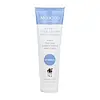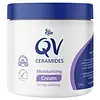What's inside
What's inside
 Key Ingredients
Key Ingredients

 Benefits
Benefits

 Concerns
Concerns

 Ingredients Side-by-side
Ingredients Side-by-side

Water
Skin ConditioningPrunus Amygdalus Dulcis Oil
Skin ConditioningOlea Europaea Fruit Oil
MaskingCocos Nucifera Oil
MaskingCetearyl Alcohol
EmollientPolysorbate 60
EmulsifyingGlyceryl Stearate Se
EmulsifyingAloe Barbadensis Leaf Juice
Skin ConditioningSqualane
EmollientPiroctone Olamine
PreservativeGuar Hydroxypropyltrimonium Chloride
Skin ConditioningMel
EmollientAllantoin
Skin ConditioningAcetum
Pyrus Communis Fruit Extract
Skin ConditioningVanilla Planifolia Fruit Extract
Skin ConditioningParfum
MaskingHydrolyzed Milk Protein
Skin ConditioningTocopherol
AntioxidantHumulus Lupulus Extract
AntimicrobialWater, Prunus Amygdalus Dulcis Oil, Olea Europaea Fruit Oil, Cocos Nucifera Oil, Cetearyl Alcohol, Polysorbate 60, Glyceryl Stearate Se, Aloe Barbadensis Leaf Juice, Squalane, Piroctone Olamine, Guar Hydroxypropyltrimonium Chloride, Mel, Allantoin, Acetum, Pyrus Communis Fruit Extract, Vanilla Planifolia Fruit Extract, Parfum, Hydrolyzed Milk Protein, Tocopherol, Humulus Lupulus Extract
Water
Skin ConditioningGlycerin
HumectantParaffinum Liquidum
EmollientPetrolatum
EmollientCetearyl Alcohol
EmollientDimethicone
EmollientCeteareth-20
CleansingStearic Acid
CleansingGlyceryl Stearate
EmollientSqualane
EmollientLaureth-3
EmulsifyingMethylparaben
PreservativeDichlorobenzyl Alcohol
AntimicrobialSodium Lauroyl Lactylate
EmulsifyingNiacinamide
SmoothingCeramide AP
Skin ConditioningCeramide NP
Skin ConditioningCeramide EOP
Skin ConditioningPhytosphingosine
Skin ConditioningCholesterol
EmollientXanthan Gum
EmulsifyingCarbomer
Emulsion StabilisingEthylhexylglycerin
Skin ConditioningWater, Glycerin, Paraffinum Liquidum, Petrolatum, Cetearyl Alcohol, Dimethicone, Ceteareth-20, Stearic Acid, Glyceryl Stearate, Squalane, Laureth-3, Methylparaben, Dichlorobenzyl Alcohol, Sodium Lauroyl Lactylate, Niacinamide, Ceramide AP, Ceramide NP, Ceramide EOP, Phytosphingosine, Cholesterol, Xanthan Gum, Carbomer, Ethylhexylglycerin
 Reviews
Reviews

Ingredients Explained
These ingredients are found in both products.
Ingredients higher up in an ingredient list are typically present in a larger amount.
Cetearyl alcohol is a mixture of two fatty alcohols: cetyl alcohol and stearyl alcohol. It is mainly used as an emulsifier. Emulsifiers help prevent the separation of oils and products. Due to its composition, it can also be used to thicken a product or help create foam.
Cetearyl alcohol is an emollient. Emollients help soothe and hydrate the skin by trapping moisture.
Studies show Cetearyl alcohol is non-toxic and non-irritating. The FDA allows products labeled "alcohol-free" to have fatty alcohols.
This ingredient is usually derived from plant oils such as palm, vegetable, or coconut oils. There is debate on whether this ingredient will cause acne.
Due to the fatty acid base, this ingredient may not be Malassezia folliculitis safe.
Learn more about Cetearyl AlcoholSqualane is an emollient that helps the skin hold onto moisture. It's an oily liquid that occurs naturally in certain types of fish and plant oils.
Because squalane boosts hydration in the skin, it also comes with plenty of benefits: it is an antioxidant and can help fight free radicals and skin damage. Squalane is also found to have a detoxifying effect when applied.
Squalane comes from squalene, which occurs naturally within the sebum of our skin. It is one of the oils our skin produces to keep itself hydrated. Squalane is the hydrogenated version of squalene and has a longer shelf life.
Research shows that squalane is non-irritating (even at 100% concentration).
In general, it's a fantastic ingredient. It does a great job at hydrating the skin, and it's suitable for those with sensitive skin.
The source of squalane may impact malassezia / fungal acne. This is because olive oil derived squalane can contain impurities such as fatty acids and plant waxes. Sugarcane derived squalane is recommended for anyone with malassezia concerns.
Is squalane vegan?
This depends on the source. Squalane can be derived from both plants and animals. Most squalane used in skincare comes from plants.
Please note: the source of squalane is only known if disclosed by the brand. We recommend reaching out to the brand if you have any questions about their squalane.
Read more about squalene with an "e".
Is squalane an oil?
Squalane is often called an oil, but it’s technically not; it’s a hydrocarbon, meaning it’s only made of carbon and hydrogen, unlike true oils which are triglycerides made of fatty acids and glycerol.
The term “oil-free” isn’t regulated, so companies can define it however they want. Some exclude all oils, while others just avoid mineral oil or comedogenic oils.
While some people avoid oils thinking they cause breakouts, the right kind of oil (or oil-like ingredient like squalane) can actually help balance and hydrate your skin. It’s worth testing out simple oils or squalane to see what works best for your skin.
Learn more about SqualaneWater. It's the most common cosmetic ingredient of all. You'll usually see it at the top of ingredient lists, meaning that it makes up the largest part of the product.
So why is it so popular? Water most often acts as a solvent - this means that it helps dissolve other ingredients into the formulation.
You'll also recognize water as that liquid we all need to stay alive. If you see this, drink a glass of water. Stay hydrated!
Learn more about Water